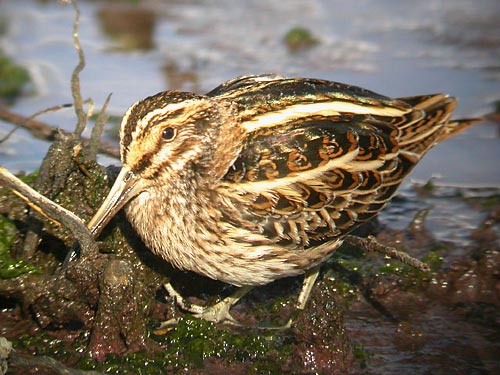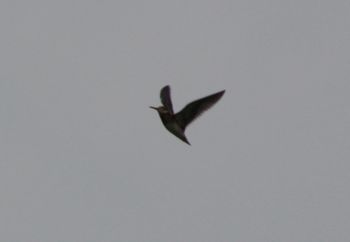(→External Links: Multiple GSearches combined) |
|||
| (17 intermediate revisions by 6 users not shown) | |||
| Line 1: | Line 1: | ||
| − | + | [[Image:Jack_Snipe.jpg|thumb|550px|right|Photo by {{user|Carl+Baggott|Carl Baggott}} <br /> Photographed: Higher Moors, St Mary's, [[Isles Of Scilly]], [[England]]]] | |
| − | [[Image:Jack_Snipe.jpg|thumb|550px|right|Photo by Carl Baggott]] | + | ;[[:Category:Lymnocryptes|Lymnocryptes]] minimus |
| + | |||
==Identification== | ==Identification== | ||
| − | + | [[File:Jack_Snipe_Flight_NAN.jpg|thumb|350px|right|''Lymnocryptes minimus''<br />Photo © by {{user|nanus|nanus}}<br /> Sainte-gemmes-sur-Loire, [[France]],<br />6 November 2009]] | |
| − | + | *Mottled brown upperparts, paler underneath | |
| − | + | *Dark stripe through the eye | |
| − | + | *Wings pointed and narrow | |
| − | + | *Yellow back stripes visible in flight | |
| + | *Habit of bobbing up and down even when otherwise standing still | ||
| + | ====Similar Species==== | ||
| + | Jack Snipe lacks the pale central crown stripe seen in for example [[Common Snipe]] which is larger and has a longer bill | ||
==Distribution== | ==Distribution== | ||
| − | + | Breeds from coastal [[Europe]] (Atlantic coast - [[UK]] and [[Scandinavia]]; Mediterranean coast) to [[Siberia]]; winters to tropical [[Africa]], [[India]] and South-east [[Asia]]. | |
| + | ==Taxonomy== | ||
| + | This is a [[Dictionary_M-O#M|monotypic]] species<sup>[[#References|[1]]]</sup>. | ||
==Habitat== | ==Habitat== | ||
| − | + | Marshes, bogs, tundra and wet meadows with short vegetation. | |
| − | |||
==Behaviour== | ==Behaviour== | ||
| + | Inclined to 'sit tight' only being flushed at the last minute | ||
| + | ====Breeding==== | ||
They nest in a well-hidden location on the ground, laying 3-4 eggs. | They nest in a well-hidden location on the ground, laying 3-4 eggs. | ||
| + | ====Diet==== | ||
| + | These birds forage in soft mud, probing or picking up food by sight. Diet includes insects and earthworms, also plant material. | ||
| + | ===Vocalisation=== | ||
| + | {{ Audio|Lymnocryptes minimus (song).mp3 }} | ||
| − | + | ==References== | |
| − | + | #{{Ref-Clements6thAug19}} | |
| − | + | {{ref}} | |
| + | ==External Links== | ||
| + | {{GSearch|"Lymnocryptes minimus" {{!}} "Jack Snipe"}} | ||
| + | {{GS-checked}} | ||
| + | <br /> | ||
| + | <br /> | ||
| − | + | [[Category:Birds]][[Category:Bird Songs]][[Category:Lymnocryptes]] | |
| − | |||
| − | |||
| − | |||
| − | |||
| − | |||
| − | |||
| − | |||
| − | |||
| − | |||
| − | [[Category: | ||
Latest revision as of 22:55, 14 December 2022
- Lymnocryptes minimus
Identification
- Mottled brown upperparts, paler underneath
- Dark stripe through the eye
- Wings pointed and narrow
- Yellow back stripes visible in flight
- Habit of bobbing up and down even when otherwise standing still
Similar Species
Jack Snipe lacks the pale central crown stripe seen in for example Common Snipe which is larger and has a longer bill
Distribution
Breeds from coastal Europe (Atlantic coast - UK and Scandinavia; Mediterranean coast) to Siberia; winters to tropical Africa, India and South-east Asia.
Taxonomy
This is a monotypic species[1].
Habitat
Marshes, bogs, tundra and wet meadows with short vegetation.
Behaviour
Inclined to 'sit tight' only being flushed at the last minute
Breeding
They nest in a well-hidden location on the ground, laying 3-4 eggs.
Diet
These birds forage in soft mud, probing or picking up food by sight. Diet includes insects and earthworms, also plant material.
Vocalisation
References
- Clements, J. F., T. S. Schulenberg, M. J. Iliff, S. M. Billerman, T. A. Fredericks, B. L. Sullivan, and C. L. Wood. 2019. The eBird/Clements Checklist of Birds of the World: v2019. Downloaded from http://www.birds.cornell.edu/clementschecklist/download/
Recommended Citation
- BirdForum Opus contributors. (2024) Jack Snipe. In: BirdForum, the forum for wild birds and birding. Retrieved 4 May 2024 from https://www.birdforum.net/opus/Jack_Snipe
External Links
GSearch checked for 2020 platform.





